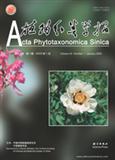1 2WANG Ying-Qiang, 1ZHANG Dian-Xiang*, 1CHEN Zhong-Yi
J Syst Evol. 2005, 43(1): 37-49.
Comparative studies on pollination biology of two floral morphs in Alpinia hainanensis were carried out in Hainan Province and Guangzhou, Guangdong Province, southern China. Populations of A. hainanensis have two floral morphs and the behaviors of stylar movements in the two floral morphs are similar to those found in other species of Alpinia previously reported. However, the stylar movement behavior of the cataflexistylous morph is 2 h slower than that of the anaflexistylous morph. There are some asynchronous stylar movements on the same floral morph, even on the same inflorescence. Yet, all anthers of the anaflexistylous floral morphs dehisce only after all stigmas of the same phenotype have moved out of the receptive position, viz., above the anthers. Our results indicate that the anaflexistylous morph has more pollen grains per flower, higher pollen/ovule ratio (P/O), and larger nectar volume than the cataflexistylous morph, while approximately equal ovule numbers, sugar and amino acid concentration. Field experiments indicate that the fruit sets are significantly high in both artificially out-crossed and self-pollinated flowers, while no fruit set was observed in bagged emasculated flowers and the unpollinated bagged flowers. These facts exhibit that A. hainanensis is self-compatible and there is no self-pollination and agamospermy in the species. There are significant differences in the fruit sets among the anaflexistylous flowers with hand-pollination treatments at different times during the day, but not in the cataflexistylous flowers. The fruit set by hand pollination is much higher than that under natural condition. This means that A. hainanensis is dependent upon insects for pollination, and insufficiency of pollinators limited fruit set under natural condition. The effective pollinators were Ameglla sp. and two species of carpenter bees (Xylocopa sp.). However, only fewer insects at a lower frequency visited flowers of A. hainanensis in nature. The breeding system of A. hainanensis is xenogamy with flexistyly.

